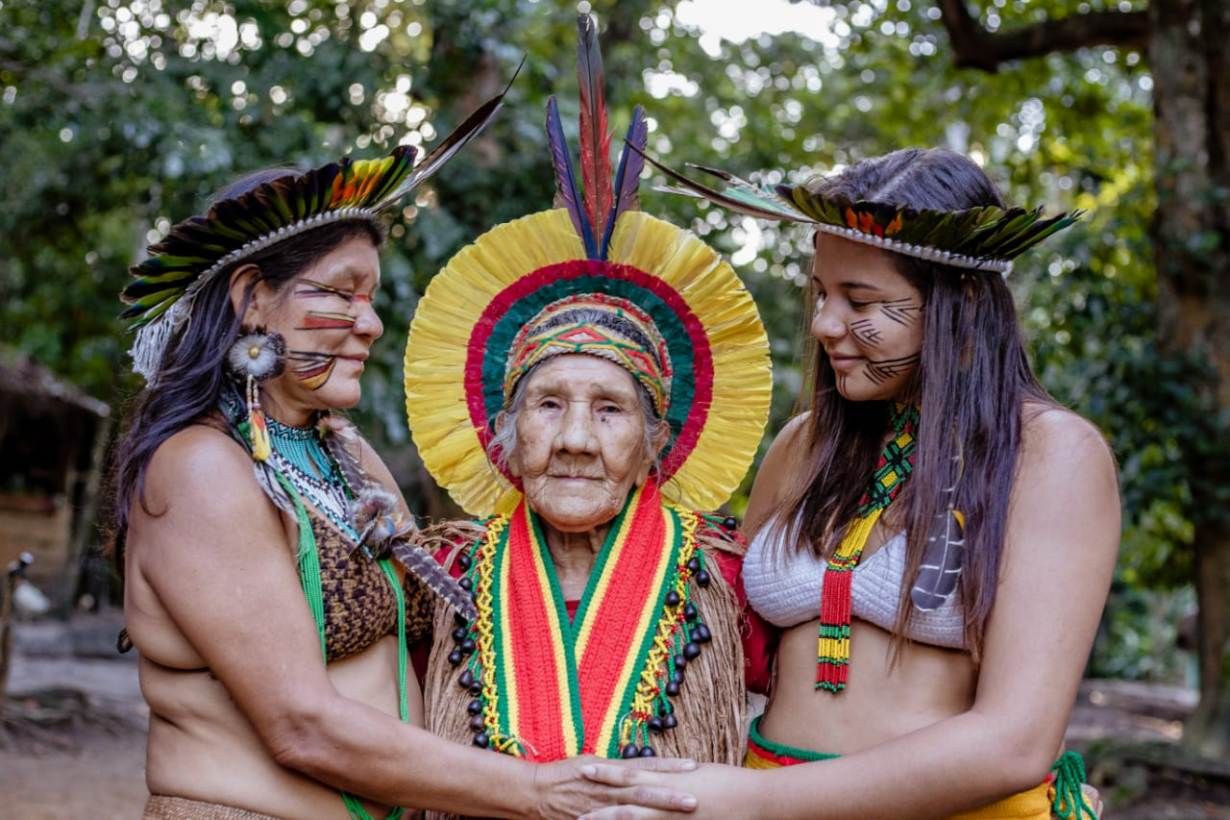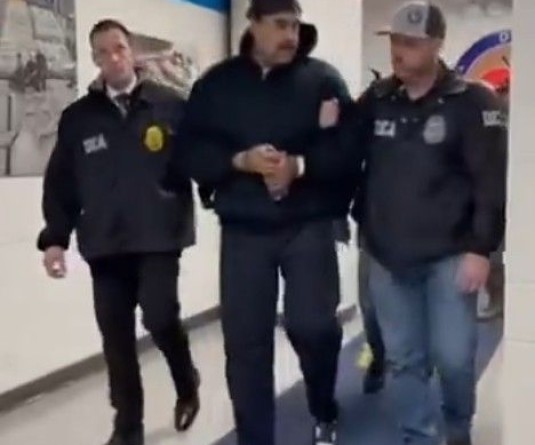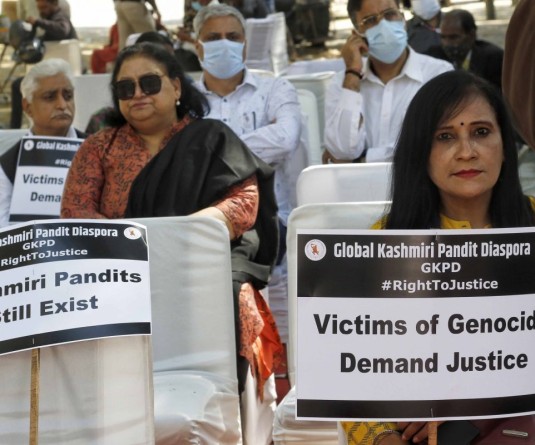Indigenous women from the Jaqueira village in northeastern Brazil perform the annual ritual Aragwaksa on August 1, 2020. Handout photos from Nitynawa Pataxo.

When indigenous communities barred tourists to protect themselves from the coronavirus, they knew they were forgoing income. But they did not foresee the loggers would move in
RIO DE JANEIRO, August 22 (Thomson Reuters Foundation) - When the coronavirus first hit Brazil in early March, local indigenous leaders barred tourists from the trails on Monte Pascoal, the first piece of land Portuguese colonizers saw as they arrived 520 years ago.
Usually, some of the about 120 inhabitants of Pe do Monte village in the northeastern state of Bahia serve as guides on the mountain, earning money to live on and to help protect the forests around them.
When community leaders closed off the village, they knew they would be forgoing vital income. But they did not expect that illegal loggers would move in.
"We used to have five trails, (but) four of them have been deforested," said indigenous leader Toho Pataxo.
"We are looking into the possibility ... of opening new trails (after the pandemic), so that tourism doesn't stop. If tourist income stops, our whole community stops."

As the pandemic decimates the tourism industry that many Brazilian indigenous villages rely on, communities are searching for solutions - from social distancing to livestreaming - to help them keep making a living and conserving their lands.
Brazil has the world's second-highest COVID-19 death toll, with more than 110,000 fatalities, according to data aggregated by Johns Hopkins University.
Official government figures show more than 380 indigenous people have died from the illness so far.
But indigenous rights groups believe that number is underreported - Brazil's Association of Indigenous People estimates it to be closer to 680 deaths.
Indigenous rights groups and health bodies like the World Health Organization have warned that indigenous communities are especially vulnerable to the virus, for reasons ranging from lack of healthcare access to invasions of their land by loggers.
At the start of the outbreak in Brazil, Funai, the government's indigenous affairs agency, suspended all authorization for outsiders to enter indigenous areas.
In Pe do Monte, Toho believes illegal loggers took advantage of the fact that the tourism freeze emptied the trails of possible witnesses to their crimes.
The people of Pe do Monte saw the trees they had spent generations protecting destroyed within five months.
"There were trees over 200 years old on those trails, but (loggers) cut them all down. They devastated our trails," he told the Thomson Reuters Foundation by phone.
FISHING TO PROTECT FORESTS
In the Amazon region, tourism is both a threat to indigenous communities - bringing them in contact with outsiders who can carry diseases - and an essential way for them to preserve their lands.
In 2018, FOIRN, an association of indigenous communities of the Rio Negro, estimated that tourism generated about 3.9 million reais ($700,000) for the villages along one of the Amazon's major rivers.
Indigenous villages are part of a monitoring project that protects the area's forests using money from tourists who engage in sports fishing, with villagers acting as their guides while also looking out for unauthorized fishing and illegal logging.
The Indigenous Sightseeing Tour of Rio Negro project protects about 3 million hectares (7.4 million acres) of forest, according to anthropologist Camila Barra, a consultant for Garupa, a non-profit organisation promoting sustainable tourism.
But with all visits canceled, the money is drying up, said Barra.
Without the funding to pay for monitoring, it will be impossible to keep away the illegal fishers and loggers who are always looking to exploit the region's resources, she noted.
"We are thinking about how to keep monitoring going ... so that when they can resume (tourism), everything is in the best possible condition," Barra added.
On the Jurubaxi River, downstream from the Rio Negro, the Sao Francisco and Acariquara indigenous communities also survive on income from sports fishing.
They partner with Kalua, a company that has exclusive rights to house tourists on riverboats and host fishing expeditions on the river while indigenous people from the two communities serve as monitors.
Last year, the project brought in about 189,000 reais for both communities, and another 65,000 reais for indigenous people directly employed by Kalua, according to Ian Sulocki, a managing partner at the company.
The ban on outsiders is unlikely to lift before the end of this year's fishing season, which means tourists might not return to the Jurubaxi until the season starts again in September 2021, said Sulocki.
And since the locals only get paid after the six-month season is over, both villages could be without tourism income until March 2022, he explained.
"To us, as a company, it's going to be quite a hit," he said.
But for the communities who rely on tourist dollars, the ban could prove disastrous, Sulocki noted.
"(For them) it's almost 20 months of no income," he said.
Funai has been delivering food parcels and hygiene kits to tide over villages during the pandemic and estimates about 151,000 indigenous people have received monthly checks as part of the government's coronavirus assistance program.
TECH TO THE RESCUE?
Sulocki said his company recently went to Funai with a proposal that could allow the rivers to reopen for sports fishing while ensuring visitors have no contact with locals.
The indigenous people could monitor the rivers and the forests from separate boats than those carrying the tourists, he suggested.
"Our challenge is showing (Funai) that ... it's possible to do tourism with zero contact," said Sulocki.
Jaqueira village in Bahia, which survives almost exclusively on tourism, may have found a way - by turning to technology.
In early August, the villagers held their Aragwaksa, an annual ceremony of reconnection with nature.
In past years, the village would fill up with visitors coming to watch the traditional ritual of singing and dancing.
This year, with no visitors allowed, the village elders decided to livestream the ceremony online, in a test drive for a "virtual tourism" initiative.
"Everything went great," said one of the village's leaders, Nitynawa Pataxo, who, like Toho, is a member of the Pataxo indigenous community.
"It was very beautiful ... we needed to do the ritual to make us stronger," she told the Thomson Reuters Foundation by phone.
Following the success of the online Aragwaksa, the village elders are planning to hold more "virtual visits" three times a week, Nitynawa said.
People from around the world will be able to log in and, for a small fee, listen to an elder speak, go on a virtual tour of the village or learn more about the community's history.
The project was due to launch next month, but was delayed as four villagers, including Nitynawa, recovered from the coronavirus.
"We are all well, we all recovered," Nitynawa said. "Now, it's time to resume our activities."






